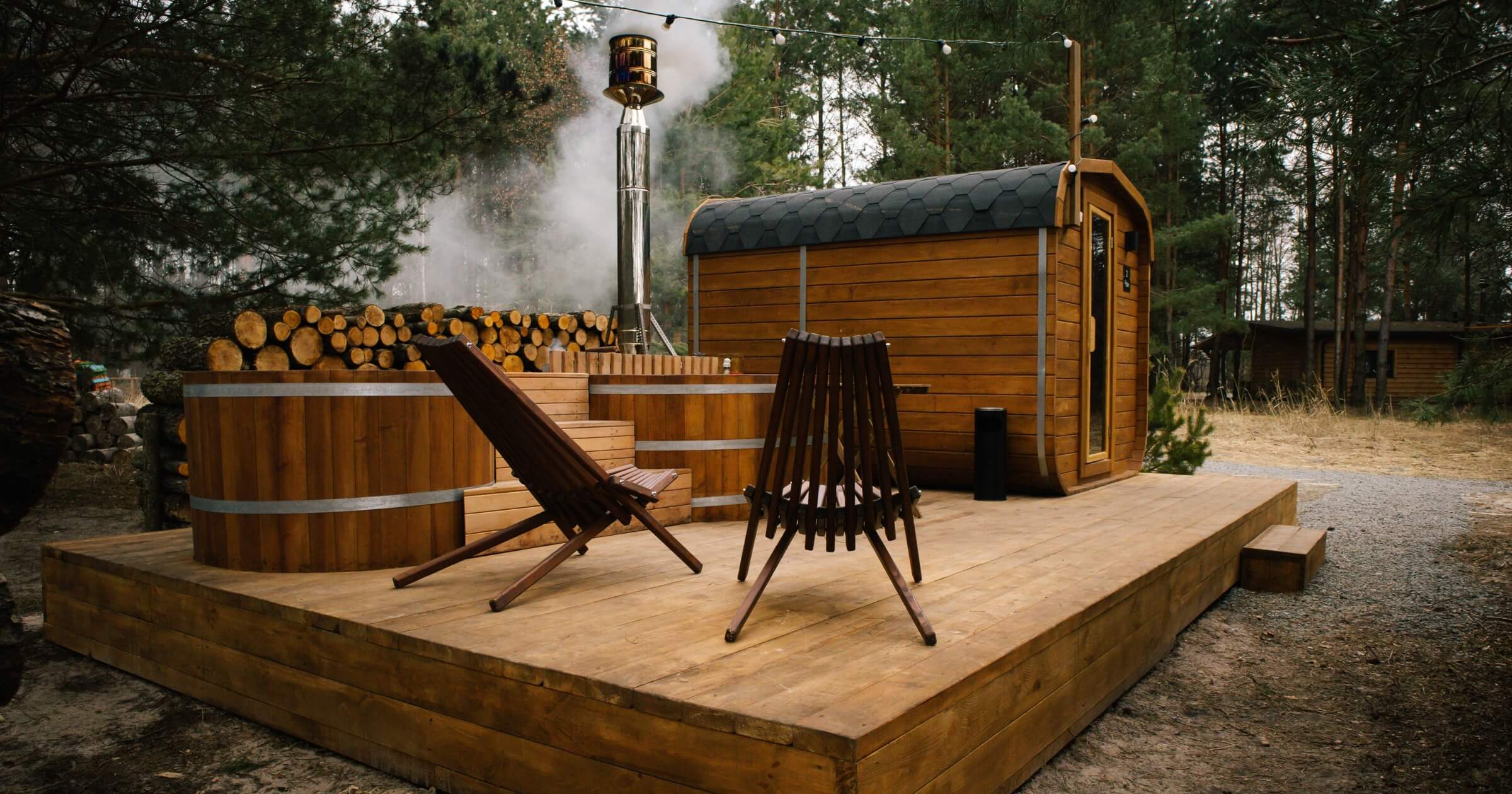Backyard saunas are a popular way to relax, ease muscle tension, and create a spa-like escape at home. The total cost can vary significantly depending on the design, materials, your location, and whether you plan to build one yourself. In this article, you’ll find everything you need to know about building a sauna including the typical backyard sauna cost so you can get planning.
Quick look
- Backyard sauna cost ranges from $1,000 to $15,000+, depending on materials, size, and labor.
- DIY builds save money but require time, tools, and skill; prefab kits and contractor builds offer convenience.
- Key cost factors include size, materials, heating type, permits, and whether you DIY or hire help.
- Planning ahead, like checking local codes, choosing the right heater, and budgeting for insulation, helps avoid surprises.
Average cost to build a backyard sauna
backyard sauna cost can range dramatically from basic DIY builds to large, contractor-built luxury saunas:
- Low-end (simple DIY): $1,000-$3,000 USD / $1,500-$4,000 CAD: for small shed-size builds, modest materials, and sweat‑equity labor.
- Mid-range (kit or prefab): $3,000-$8,000 USD / $4,000-$10,000 CAD: includes better wood and heater options; labor may be DIY or contracted.
- High-end (custom, premium): $10,000-$15,000 USD+ / $13,000-$20,000 CAD+: larger footprint, premium cedar, custom designs, and complete contractor services.
Why the spread?
Home renovation sites report that a typical sauna costs around $3,100 on average, with prefab and traditional installations ranging from $1,500 to $10,000 USD. High‑end options, especially custom cabins, can exceed that substantially. Canadian retailers list premium outdoor saunas starting near $6,500 CAD and going well over $15,000.
Some sources report more realistic DIY outcomes. For example, a DIY 8′ × 12′ (8′ × 6′ hot room) build ran about $4,000 USD, including materials and a wood stove. Another DIY project logged total material costs near $7,300 USD, plus about $3,000 USD in contracted labor, bringing the total to around $10,300 USD.
Cost Comparison Table
| Sauna Type | US Estimate (USD) | Canada Estimate (CAD) |
| Basic DIY (shed size) | $1,000-$3,000 | $1,500-$4,000 |
| Mid‑range kit or prefab | $3,000-$8,000 | $4,000-$10,000 |
| Custom‑built, premium | $10,000-$15,000+ | $13,000-$20,000+ |
Key factors affecting the cost of a backyard sauna
The cost of a backyard sauna depends on a mix of factors, including size, materials, and the type of heater you install. Each of these choices can raise or lower your overall spending.
Size: Bigger builds = higher cost
The overall footprint of your sauna is one of the most significant cost drivers. A small 4′ by 6′ sauna may only require a few hundred dollars in materials if you’re building it yourself, while something more spacious, like an 8′ by 12′ sauna with a changing area, can quickly double or triple those costs.
Larger saunas require more lumber for framing and siding, additional insulation to retain heat, and a higher-capacity heater to maintain consistent temperatures. You’ll also likely spend more on benches, windows, and other interior finishes. And because a bigger structure can increase complexity, labor and permitting costs of building a backyard sauna often go up as well.
Materials: Budget vs premium options
The materials you choose to build with will have a big impact on the backyard sauna cost. Wood is the most common choice; some are naturally resistant to heat and moisture, while others are more affordable but require extra care or maintenance. Below are some of the most commonly used materials, along with their pros and cons:
Cedar
- Pro: Pleasant natural aroma
- Pro: Naturally resists moisture and decay
- Con: One of the most expensive wood options
Spruce
- Pro: Budget-friendly
- Pro: Clean, bright appearance
- Con: Less resistant to long-term heat and moisture exposure
Hemlock
- Pro: Smooth, splinter-free surface
- Pro: Holds up well in heat
- Con: Costs more than spruce, but less than cedar
Composite or recycled wood
- Pro: Affordable and often eco-friendly
- Pro: Available in pre-treated or engineered options
- Con: Can off-gas under heat
- Con: May not last as long as natural wood
Cedar is considered the “gold standard” for saunas due to its durability and scent, but spruce and hemlock can be excellent alternatives if you’re looking to save. If you’re building on a tight budget or experimenting with a temporary setup, recycled or engineered wood products may offer a low-cost entry point, but be sure they’re safe for high-heat environments.
Complexity: Simple vs custom design
Simple sauna designs are easier on the budget. A basic shed-style build with one hot room uses fewer materials, is easier to insulate, and takes less time to assemble. It’s a practical choice to keep costs down.
Understandably, more complex designs mean higher prices. Features like glass doors, multiple rooms, an outdoor deck, or a built-in shower all add to the materials and labor needed. For example, adding a changing area means you’ll need more space, extra insulation, and possibly electrical work. Large windows or glass panels look great but have to be rated for high heat and properly installed, which makes the build more complicated and expensive.
Labor: DIY vs contractor pricing
Deciding whether to build your sauna yourself or hire a contractor makes a big difference in the final cost. Doing it on your own can save a lot of money, especially on labor. It also gives you more flexibility with materials and timing. For someone with basic skills and a few tools, a weekend build is possible, especially with a kit that comes pre-cut and ready to go.
Going with a contractor takes the pressure off and speeds things up. Pros can handle trickier parts of the job, like electrical work or ventilation, and make sure everything meets local codes. However, that convenience comes with a higher price tag. Labor alone can make up 30 to 50 percent of your total budget, depending on where you live and how complex the project is.
Location: Regional differences
Where you live can have a big impact on the total cost of your backyard sauna. In urban areas, everything from labor rates to permit fees tends to be higher. Contractors often charge more in cities due to increased demand, limited space for construction, and added logistical challenges like parking or delivery access.
Material costs can also vary by region. For example, cedar may be more affordable in the Pacific Northwest, where it’s commonly sourced, but more expensive on the East Coast or Midwest. If you live in a remote or rural area, you might find lower labor rates but may need to pay extra for shipping materials or wait longer for delivery.
Climate plays a role, too. In colder areas, you’ll need better insulation and a more powerful heater, both of which add to the cost. Wherever you’re located, it’s worth pricing out both local and online suppliers to compare rates and availability before starting your build.
Permits: Local building code cost
Before breaking ground on your backyard sauna, it’s important to check local building codes and permit requirements. Many municipalities require permits for outbuildings over a specific size, especially if they include electrical work, plumbing, or wood-burning stoves.
Permit costs can vary significantly depending on your location and the complexity of the project. In the U.S., you might pay anywhere from $0 to $400 or more for a basic building permit. In Canada, fees are often based on the size of the structure or the estimated value of the build. If your sauna includes electrical work or plumbing, like lighting, a heater, or an outdoor shower, you may need separate inspections, each with its own fee.
Skipping permits can lead to fines or problems down the road, especially if you decide to sell your home. It’s a good idea to check with your local building department early in the planning process to understand what is required.
Heating source: Wood stove vs electric vs infrared
Choosing the right heating source is a key part of planning your backyard sauna. Each option comes with its own pros, cons, and cost considerations.
- Electric heaters are a popular pick for backyard saunas. They’re simple to use, heat up fast, and give you reasonable control over the temperature. The main catch is that they often require a 240-volt power line, which might necessitate bringing in an electrician. That can increase your overall cost, especially if your sauna is located far from the main panel.
- Wood-burning stoves offer that classic sauna feel. There’s no need for electricity, and the natural wood scent really enhances the experience. On the flip side, they require more upkeep, good ventilation, and lots of firewood. Some areas may also have tighter rules around emissions and wood stove use.
- Infrared heaters work a bit differently. Instead of heating the air, they warm your body directly. These are usually found in smaller or indoor saunas and are more energy efficient. They’re easy to set up and use less power, but they don’t deliver the same kind of steam-based experience that traditional sauna lovers look for.
The best option for you will depend on your budget, location, and how you want to use your sauna. For an authentic, immersive experience, wood or electric is often preferred. If simplicity is your priority, infrared might be the way to go.
The simplest ways to build a sauna in your backyard
There are several ways to bring a sauna into your outdoor space, and some are easier than you think. Whether you’re looking to build from the ground up or want something more turn-key, there are options to fit a range of skill levels and budgets.
- DIY from scratch: You’ll need to build the frame, insulate the walls and ceiling, install benches, and set up your heating system. This is the most hands-on and budget-friendly option. It takes more time and effort, but gives you full control over the design and materials.
- DIY sauna kits: These prefab kits come with lumber, hardware, and a compatible heater, making the project much easier than starting from scratch. They’re ideal for those who want to save money but still get a professional-looking result.
- Prefab or modular saunas: Manufactured off-site, these saunas are delivered to your home ready to assemble or nearly complete. They cost more but offer high quality and convenience, often going up in just a day or two with minimal tools.
- Converted sheds or cabins: If you already have a small outbuilding, it can be converted into a sauna with insulation, wood paneling, and the right heater. This can be a great way to save money and reduce construction time.
- Barrel saunas: These eye-catching, rounded saunas are popular for their unique shape and heat circulation. Most come in easy-to-assemble kits and occupy less space, making them perfect for smaller yards.
Things to consider before building a sauna in your backyard
Before you start gathering materials or ordering a kit, it’s important to think through a few practical details. A little planning now can help you avoid costly surprises later.
- Research local bylaws and permitting requirements: Check with your local building department to determine if a permit is necessary for your sauna. Some areas have restrictions on wood-burning stoves, electrical work, or the proximity of structures to property lines.
- Compare costs of DIY vs contractor: Be honest about your skills, available time, and budget. While DIY can save money, hiring a contractor may be the better choice if your design is complex or if local codes require licensed work.
- Choose your heating type based on comfort and convenience: Each heating source has its benefits, so consider what fits your lifestyle. If you want low maintenance, electric may be best. If you prefer an off-grid or more traditional feel, wood-burning might be worth the maintenance.
- Plan for drainage, ventilation, and safety: Proper drainage prevents water damage, while good ventilation provides optimal air quality and consistent temperatures. Don’t forget about fire safety, especially if you’re using a wood stove.
- Check product warranties and lifespan for materials: Choose materials and components that are rated for sauna use and come with solid warranties, so you know they’ll last in high heat and humidity.
Taking time to plan these elements will help your sauna stay safe, comfortable, and enjoyable for years to come.
Want more DIY ideas and smart home upgrades? Subscribe to our newsletter.


